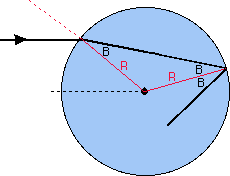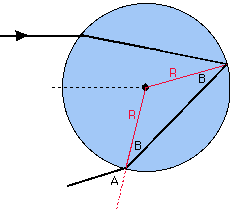Also, the radius of the circle is R
and the height of the point where the ray hits the sphere is h.
Since the ray and the horizontal dashed line are parallel, the angle between
the horizontal dashed line and the radius line is also A.
But that means, by looking at the triangle formed by R,
h,
and the dashed line we can write sin(A) = h / R. Let's simplify
this by defining H = h / R. Clearly for all the rays that hit the
upper half of the sphere, H runs from 0 to 1.
Now for the reflection off the back surface. The triangle formed by the
two Radii and the ray is clearly an isosceles triangle which means the
angles at the base (the black ray side) are the same. So at the back surface
the light also makes an angle with the radius of
B.


We know that the angle of incidence equals the angle of
reflection so the angle the bounced ray makes with the radius is also B.
Finally, via Snell's law again we see that since the incident angle is
B
the angle the outgoing ray makes with the extended radius must again be
A.
n * sin(B) = sin(A) (again)
continue
back home |

